Detailed Presentation Review: EAL/D and Aboriginal Education
VerifiedAdded on 2023/06/03
|7
|1557
|115
Report
AI Summary
This report presents a review of presentations focusing on English as an Additional Language or Dialect (EAL/D) and Aboriginal and Torres Strait Islander students. The first presentation discusses the challenges faced by EAL/D students, particularly those from remote areas, and emphasizes the importance of culturally responsive teaching, grouping students based on their language proficiency, and utilizing students' cultural understanding to facilitate learning. The second presentation addresses the educational challenges faced by Aboriginal students, including health issues, cultural barriers, and historical trauma. It underscores the need for educators to avoid imposing cultural changes, respect the students' native language, and provide specialized support to address their unique needs. The review highlights the application of this knowledge in creating inclusive and effective learning environments for diverse student populations, with a focus on cultural sensitivity and tailored teaching strategies.
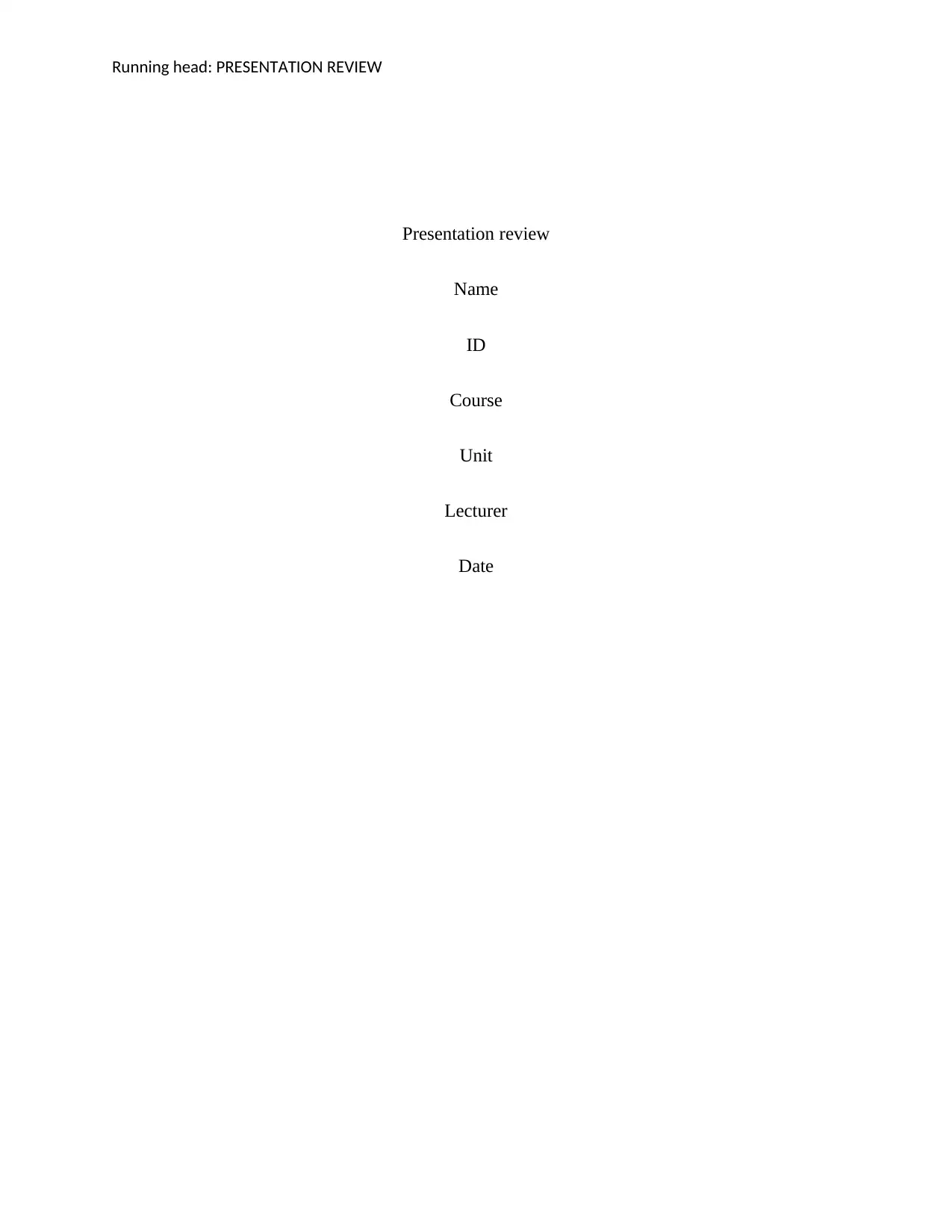
Running head: PRESENTATION REVIEW
Presentation review
Name
ID
Course
Unit
Lecturer
Date
Presentation review
Name
ID
Course
Unit
Lecturer
Date
Paraphrase This Document
Need a fresh take? Get an instant paraphrase of this document with our AI Paraphraser
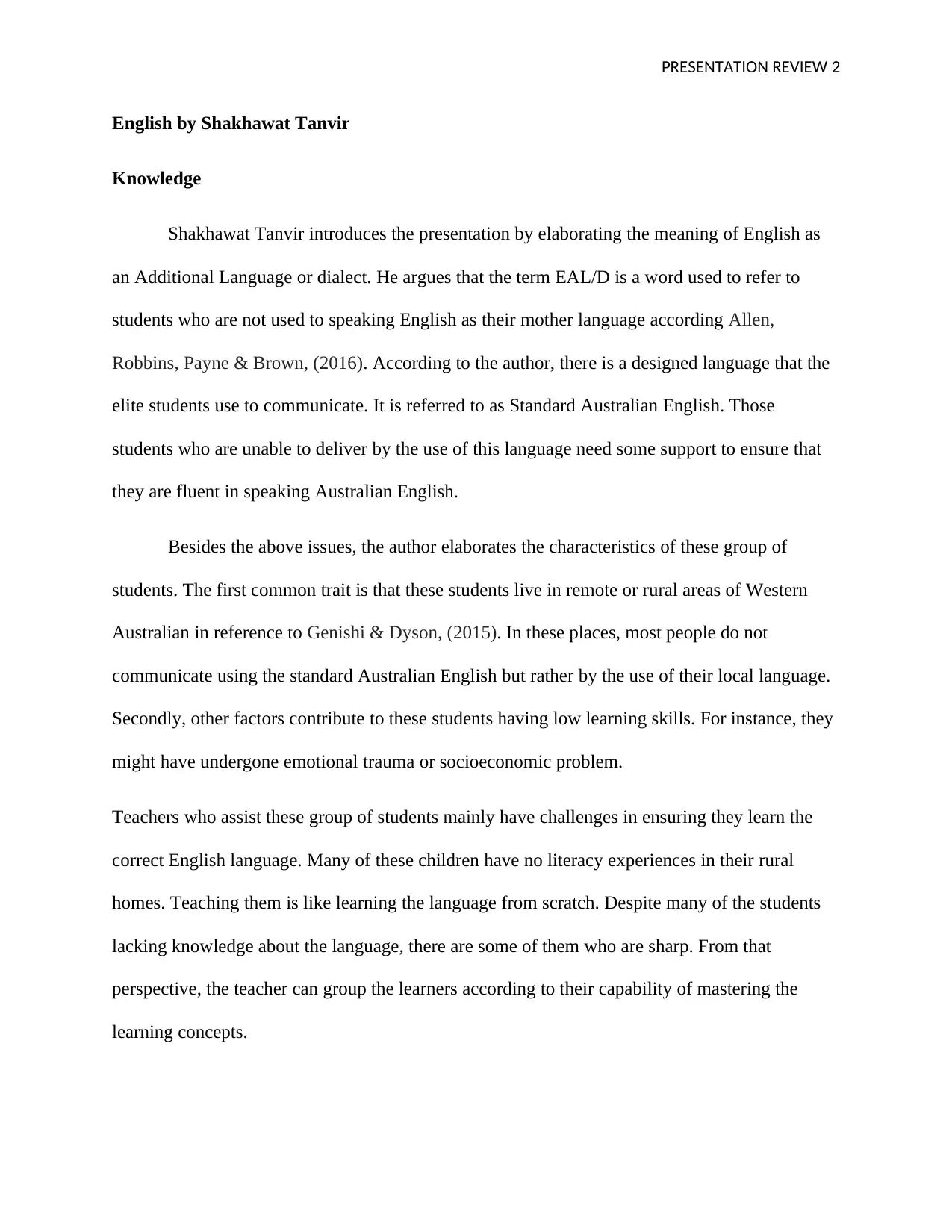
PRESENTATION REVIEW 2
English by Shakhawat Tanvir
Knowledge
Shakhawat Tanvir introduces the presentation by elaborating the meaning of English as
an Additional Language or dialect. He argues that the term EAL/D is a word used to refer to
students who are not used to speaking English as their mother language according Allen,
Robbins, Payne & Brown, (2016). According to the author, there is a designed language that the
elite students use to communicate. It is referred to as Standard Australian English. Those
students who are unable to deliver by the use of this language need some support to ensure that
they are fluent in speaking Australian English.
Besides the above issues, the author elaborates the characteristics of these group of
students. The first common trait is that these students live in remote or rural areas of Western
Australian in reference to Genishi & Dyson, (2015). In these places, most people do not
communicate using the standard Australian English but rather by the use of their local language.
Secondly, other factors contribute to these students having low learning skills. For instance, they
might have undergone emotional trauma or socioeconomic problem.
Teachers who assist these group of students mainly have challenges in ensuring they learn the
correct English language. Many of these children have no literacy experiences in their rural
homes. Teaching them is like learning the language from scratch. Despite many of the students
lacking knowledge about the language, there are some of them who are sharp. From that
perspective, the teacher can group the learners according to their capability of mastering the
learning concepts.
English by Shakhawat Tanvir
Knowledge
Shakhawat Tanvir introduces the presentation by elaborating the meaning of English as
an Additional Language or dialect. He argues that the term EAL/D is a word used to refer to
students who are not used to speaking English as their mother language according Allen,
Robbins, Payne & Brown, (2016). According to the author, there is a designed language that the
elite students use to communicate. It is referred to as Standard Australian English. Those
students who are unable to deliver by the use of this language need some support to ensure that
they are fluent in speaking Australian English.
Besides the above issues, the author elaborates the characteristics of these group of
students. The first common trait is that these students live in remote or rural areas of Western
Australian in reference to Genishi & Dyson, (2015). In these places, most people do not
communicate using the standard Australian English but rather by the use of their local language.
Secondly, other factors contribute to these students having low learning skills. For instance, they
might have undergone emotional trauma or socioeconomic problem.
Teachers who assist these group of students mainly have challenges in ensuring they learn the
correct English language. Many of these children have no literacy experiences in their rural
homes. Teaching them is like learning the language from scratch. Despite many of the students
lacking knowledge about the language, there are some of them who are sharp. From that
perspective, the teacher can group the learners according to their capability of mastering the
learning concepts.
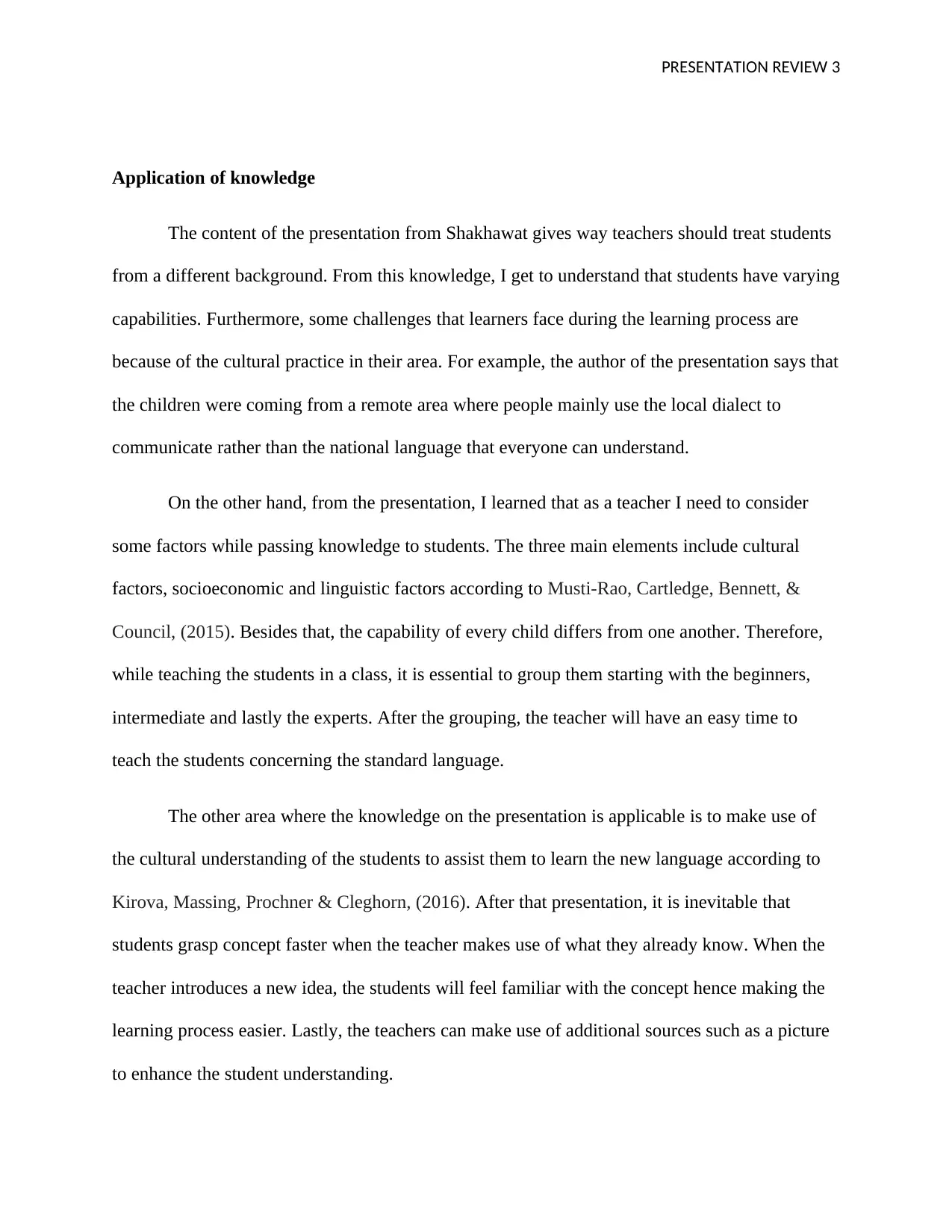
PRESENTATION REVIEW 3
Application of knowledge
The content of the presentation from Shakhawat gives way teachers should treat students
from a different background. From this knowledge, I get to understand that students have varying
capabilities. Furthermore, some challenges that learners face during the learning process are
because of the cultural practice in their area. For example, the author of the presentation says that
the children were coming from a remote area where people mainly use the local dialect to
communicate rather than the national language that everyone can understand.
On the other hand, from the presentation, I learned that as a teacher I need to consider
some factors while passing knowledge to students. The three main elements include cultural
factors, socioeconomic and linguistic factors according to Musti-Rao, Cartledge, Bennett, &
Council, (2015). Besides that, the capability of every child differs from one another. Therefore,
while teaching the students in a class, it is essential to group them starting with the beginners,
intermediate and lastly the experts. After the grouping, the teacher will have an easy time to
teach the students concerning the standard language.
The other area where the knowledge on the presentation is applicable is to make use of
the cultural understanding of the students to assist them to learn the new language according to
Kirova, Massing, Prochner & Cleghorn, (2016). After that presentation, it is inevitable that
students grasp concept faster when the teacher makes use of what they already know. When the
teacher introduces a new idea, the students will feel familiar with the concept hence making the
learning process easier. Lastly, the teachers can make use of additional sources such as a picture
to enhance the student understanding.
Application of knowledge
The content of the presentation from Shakhawat gives way teachers should treat students
from a different background. From this knowledge, I get to understand that students have varying
capabilities. Furthermore, some challenges that learners face during the learning process are
because of the cultural practice in their area. For example, the author of the presentation says that
the children were coming from a remote area where people mainly use the local dialect to
communicate rather than the national language that everyone can understand.
On the other hand, from the presentation, I learned that as a teacher I need to consider
some factors while passing knowledge to students. The three main elements include cultural
factors, socioeconomic and linguistic factors according to Musti-Rao, Cartledge, Bennett, &
Council, (2015). Besides that, the capability of every child differs from one another. Therefore,
while teaching the students in a class, it is essential to group them starting with the beginners,
intermediate and lastly the experts. After the grouping, the teacher will have an easy time to
teach the students concerning the standard language.
The other area where the knowledge on the presentation is applicable is to make use of
the cultural understanding of the students to assist them to learn the new language according to
Kirova, Massing, Prochner & Cleghorn, (2016). After that presentation, it is inevitable that
students grasp concept faster when the teacher makes use of what they already know. When the
teacher introduces a new idea, the students will feel familiar with the concept hence making the
learning process easier. Lastly, the teachers can make use of additional sources such as a picture
to enhance the student understanding.
⊘ This is a preview!⊘
Do you want full access?
Subscribe today to unlock all pages.

Trusted by 1+ million students worldwide
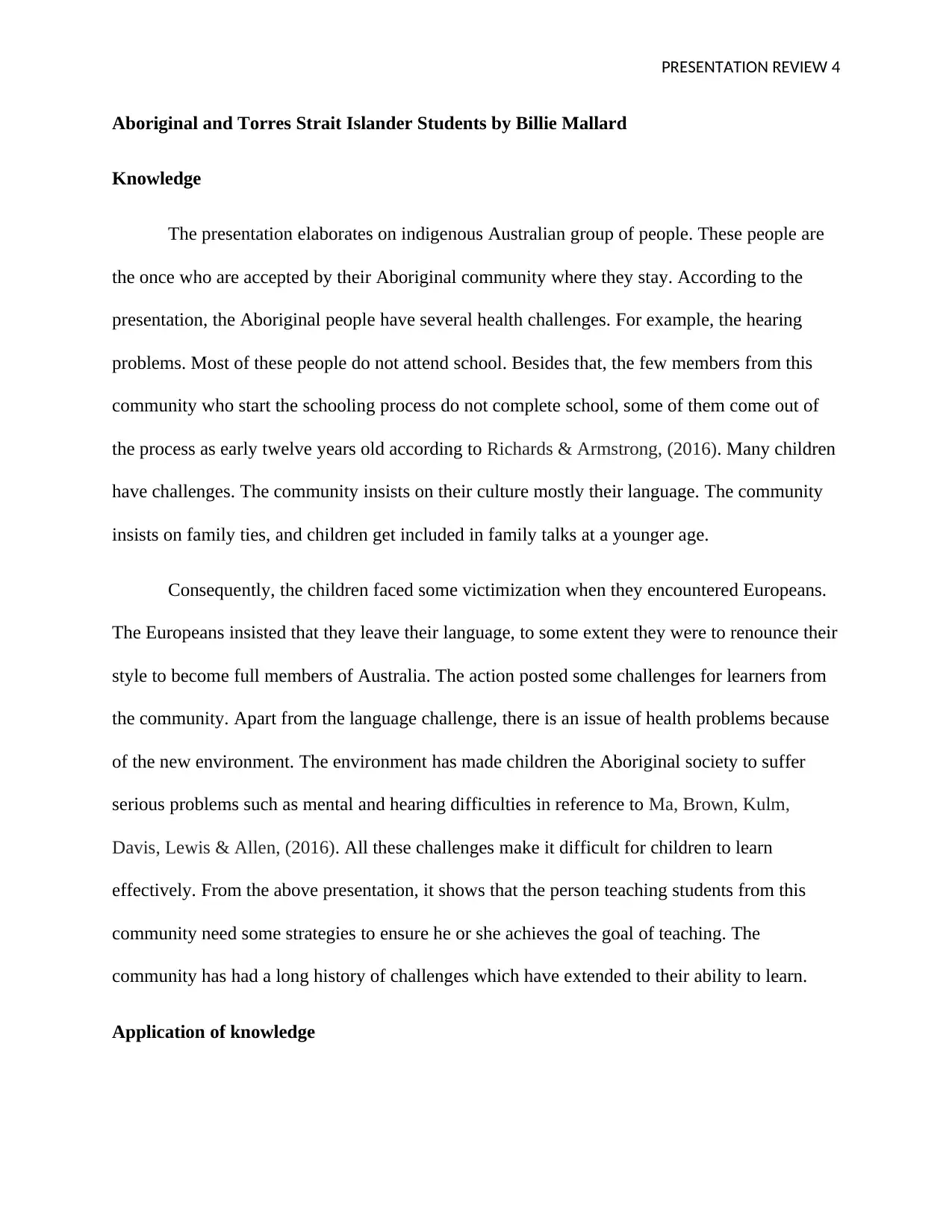
PRESENTATION REVIEW 4
Aboriginal and Torres Strait Islander Students by Billie Mallard
Knowledge
The presentation elaborates on indigenous Australian group of people. These people are
the once who are accepted by their Aboriginal community where they stay. According to the
presentation, the Aboriginal people have several health challenges. For example, the hearing
problems. Most of these people do not attend school. Besides that, the few members from this
community who start the schooling process do not complete school, some of them come out of
the process as early twelve years old according to Richards & Armstrong, (2016). Many children
have challenges. The community insists on their culture mostly their language. The community
insists on family ties, and children get included in family talks at a younger age.
Consequently, the children faced some victimization when they encountered Europeans.
The Europeans insisted that they leave their language, to some extent they were to renounce their
style to become full members of Australia. The action posted some challenges for learners from
the community. Apart from the language challenge, there is an issue of health problems because
of the new environment. The environment has made children the Aboriginal society to suffer
serious problems such as mental and hearing difficulties in reference to Ma, Brown, Kulm,
Davis, Lewis & Allen, (2016). All these challenges make it difficult for children to learn
effectively. From the above presentation, it shows that the person teaching students from this
community need some strategies to ensure he or she achieves the goal of teaching. The
community has had a long history of challenges which have extended to their ability to learn.
Application of knowledge
Aboriginal and Torres Strait Islander Students by Billie Mallard
Knowledge
The presentation elaborates on indigenous Australian group of people. These people are
the once who are accepted by their Aboriginal community where they stay. According to the
presentation, the Aboriginal people have several health challenges. For example, the hearing
problems. Most of these people do not attend school. Besides that, the few members from this
community who start the schooling process do not complete school, some of them come out of
the process as early twelve years old according to Richards & Armstrong, (2016). Many children
have challenges. The community insists on their culture mostly their language. The community
insists on family ties, and children get included in family talks at a younger age.
Consequently, the children faced some victimization when they encountered Europeans.
The Europeans insisted that they leave their language, to some extent they were to renounce their
style to become full members of Australia. The action posted some challenges for learners from
the community. Apart from the language challenge, there is an issue of health problems because
of the new environment. The environment has made children the Aboriginal society to suffer
serious problems such as mental and hearing difficulties in reference to Ma, Brown, Kulm,
Davis, Lewis & Allen, (2016). All these challenges make it difficult for children to learn
effectively. From the above presentation, it shows that the person teaching students from this
community need some strategies to ensure he or she achieves the goal of teaching. The
community has had a long history of challenges which have extended to their ability to learn.
Application of knowledge
Paraphrase This Document
Need a fresh take? Get an instant paraphrase of this document with our AI Paraphraser
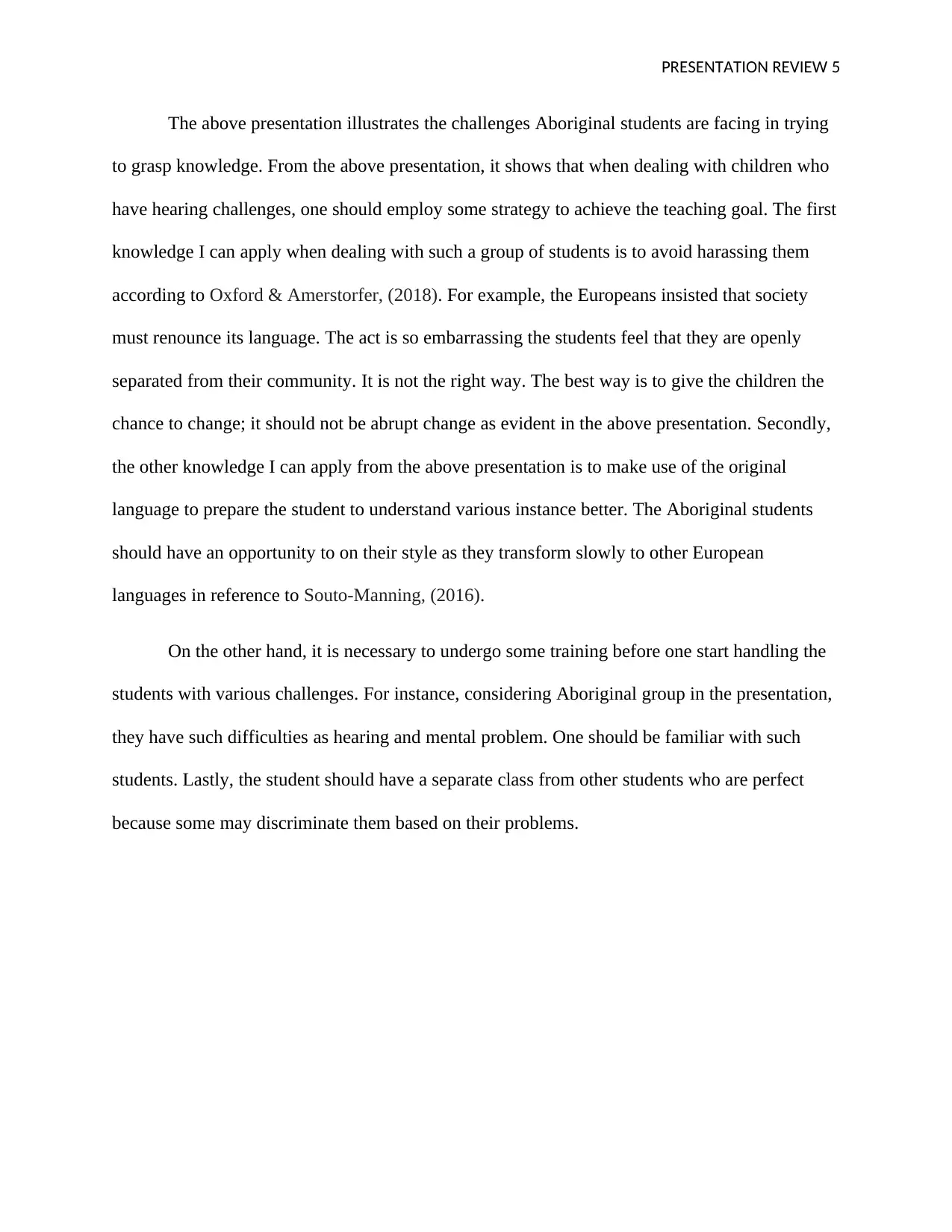
PRESENTATION REVIEW 5
The above presentation illustrates the challenges Aboriginal students are facing in trying
to grasp knowledge. From the above presentation, it shows that when dealing with children who
have hearing challenges, one should employ some strategy to achieve the teaching goal. The first
knowledge I can apply when dealing with such a group of students is to avoid harassing them
according to Oxford & Amerstorfer, (2018). For example, the Europeans insisted that society
must renounce its language. The act is so embarrassing the students feel that they are openly
separated from their community. It is not the right way. The best way is to give the children the
chance to change; it should not be abrupt change as evident in the above presentation. Secondly,
the other knowledge I can apply from the above presentation is to make use of the original
language to prepare the student to understand various instance better. The Aboriginal students
should have an opportunity to on their style as they transform slowly to other European
languages in reference to Souto‐Manning, (2016).
On the other hand, it is necessary to undergo some training before one start handling the
students with various challenges. For instance, considering Aboriginal group in the presentation,
they have such difficulties as hearing and mental problem. One should be familiar with such
students. Lastly, the student should have a separate class from other students who are perfect
because some may discriminate them based on their problems.
The above presentation illustrates the challenges Aboriginal students are facing in trying
to grasp knowledge. From the above presentation, it shows that when dealing with children who
have hearing challenges, one should employ some strategy to achieve the teaching goal. The first
knowledge I can apply when dealing with such a group of students is to avoid harassing them
according to Oxford & Amerstorfer, (2018). For example, the Europeans insisted that society
must renounce its language. The act is so embarrassing the students feel that they are openly
separated from their community. It is not the right way. The best way is to give the children the
chance to change; it should not be abrupt change as evident in the above presentation. Secondly,
the other knowledge I can apply from the above presentation is to make use of the original
language to prepare the student to understand various instance better. The Aboriginal students
should have an opportunity to on their style as they transform slowly to other European
languages in reference to Souto‐Manning, (2016).
On the other hand, it is necessary to undergo some training before one start handling the
students with various challenges. For instance, considering Aboriginal group in the presentation,
they have such difficulties as hearing and mental problem. One should be familiar with such
students. Lastly, the student should have a separate class from other students who are perfect
because some may discriminate them based on their problems.
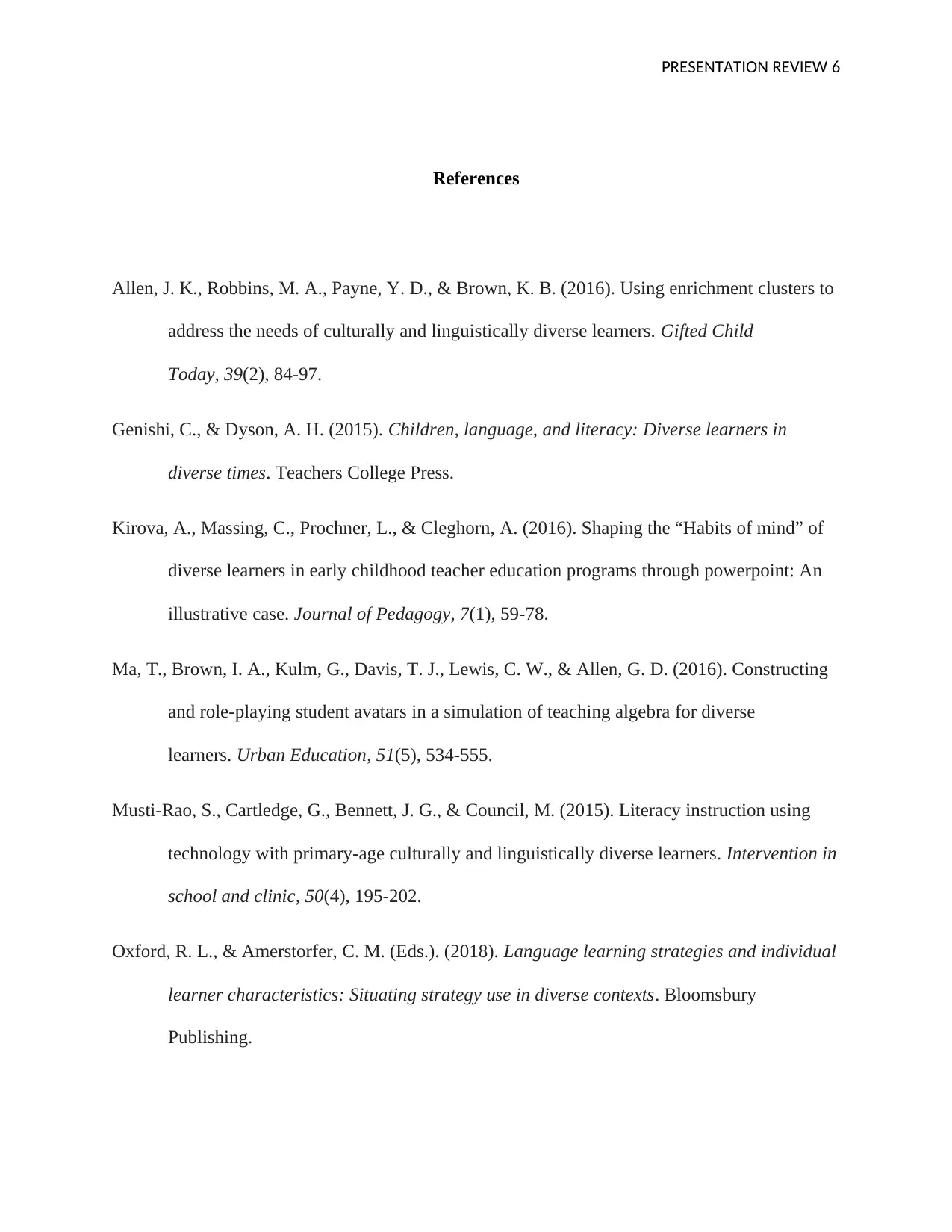
PRESENTATION REVIEW 6
References
Allen, J. K., Robbins, M. A., Payne, Y. D., & Brown, K. B. (2016). Using enrichment clusters to
address the needs of culturally and linguistically diverse learners. Gifted Child
Today, 39(2), 84-97.
Genishi, C., & Dyson, A. H. (2015). Children, language, and literacy: Diverse learners in
diverse times. Teachers College Press.
Kirova, A., Massing, C., Prochner, L., & Cleghorn, A. (2016). Shaping the “Habits of mind” of
diverse learners in early childhood teacher education programs through powerpoint: An
illustrative case. Journal of Pedagogy, 7(1), 59-78.
Ma, T., Brown, I. A., Kulm, G., Davis, T. J., Lewis, C. W., & Allen, G. D. (2016). Constructing
and role-playing student avatars in a simulation of teaching algebra for diverse
learners. Urban Education, 51(5), 534-555.
Musti-Rao, S., Cartledge, G., Bennett, J. G., & Council, M. (2015). Literacy instruction using
technology with primary-age culturally and linguistically diverse learners. Intervention in
school and clinic, 50(4), 195-202.
Oxford, R. L., & Amerstorfer, C. M. (Eds.). (2018). Language learning strategies and individual
learner characteristics: Situating strategy use in diverse contexts. Bloomsbury
Publishing.
References
Allen, J. K., Robbins, M. A., Payne, Y. D., & Brown, K. B. (2016). Using enrichment clusters to
address the needs of culturally and linguistically diverse learners. Gifted Child
Today, 39(2), 84-97.
Genishi, C., & Dyson, A. H. (2015). Children, language, and literacy: Diverse learners in
diverse times. Teachers College Press.
Kirova, A., Massing, C., Prochner, L., & Cleghorn, A. (2016). Shaping the “Habits of mind” of
diverse learners in early childhood teacher education programs through powerpoint: An
illustrative case. Journal of Pedagogy, 7(1), 59-78.
Ma, T., Brown, I. A., Kulm, G., Davis, T. J., Lewis, C. W., & Allen, G. D. (2016). Constructing
and role-playing student avatars in a simulation of teaching algebra for diverse
learners. Urban Education, 51(5), 534-555.
Musti-Rao, S., Cartledge, G., Bennett, J. G., & Council, M. (2015). Literacy instruction using
technology with primary-age culturally and linguistically diverse learners. Intervention in
school and clinic, 50(4), 195-202.
Oxford, R. L., & Amerstorfer, C. M. (Eds.). (2018). Language learning strategies and individual
learner characteristics: Situating strategy use in diverse contexts. Bloomsbury
Publishing.
⊘ This is a preview!⊘
Do you want full access?
Subscribe today to unlock all pages.

Trusted by 1+ million students worldwide
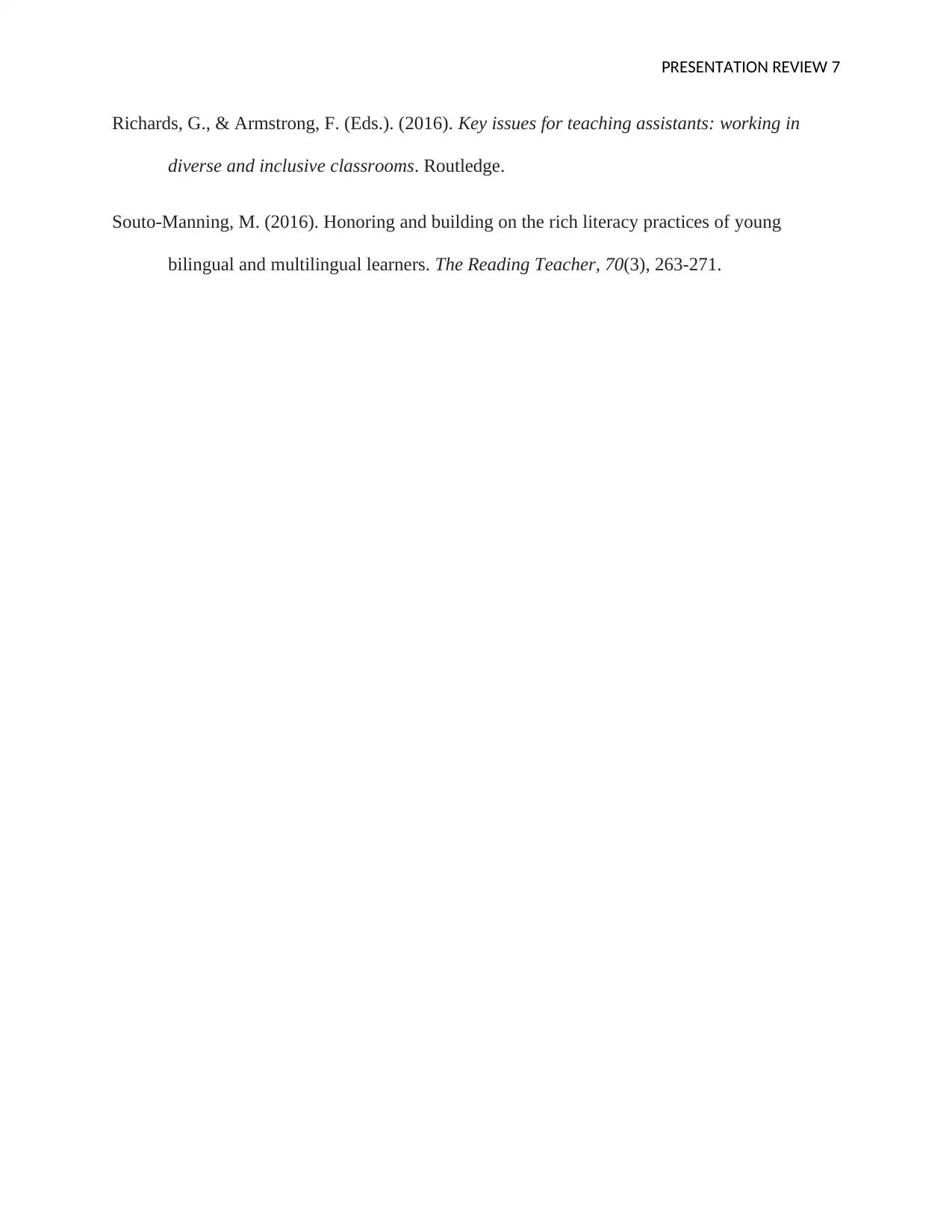
PRESENTATION REVIEW 7
Richards, G., & Armstrong, F. (Eds.). (2016). Key issues for teaching assistants: working in
diverse and inclusive classrooms. Routledge.
Souto‐Manning, M. (2016). Honoring and building on the rich literacy practices of young
bilingual and multilingual learners. The Reading Teacher, 70(3), 263-271.
Richards, G., & Armstrong, F. (Eds.). (2016). Key issues for teaching assistants: working in
diverse and inclusive classrooms. Routledge.
Souto‐Manning, M. (2016). Honoring and building on the rich literacy practices of young
bilingual and multilingual learners. The Reading Teacher, 70(3), 263-271.
1 out of 7
Related Documents
Your All-in-One AI-Powered Toolkit for Academic Success.
+13062052269
info@desklib.com
Available 24*7 on WhatsApp / Email
![[object Object]](/_next/static/media/star-bottom.7253800d.svg)
Unlock your academic potential
Copyright © 2020–2025 A2Z Services. All Rights Reserved. Developed and managed by ZUCOL.





